The Health Education Assets Library (HEAL) is a collection of over 22,000 freely available digital materials for health sciences education. The collection is now housed at the University of Utah J. Willard Marriott Digital Library.
TO
| Title | Description | Subject | Collection | ||
|---|---|---|---|---|---|
| 26 |
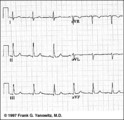 |
Frontal plane QRS axis = +75 degrees | Since there is no isoelectric lead in this ECG, the two closest leads are I and aVL. If I were isoelectric, the axis would be +90 degrees; if aVL were isoelectric, the axis would be +60 degrees. A nice compromize is +75 degrees. (The two closest leads are always 30 degrees apart.) | Knowledge Weavers ECG | |
| 27 |
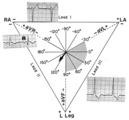 |
Right axis deviation: QRS axis = +130 degrees | Lead aVR is almost isoelectric; lead I is mostly negative, and lead III is very positive. The QRS axis, therefore, is +130 degrees. Note that the slightly more positive AVR moves the axis slightly beyond +120 degrees; i.e., closer to the + pole of the aVR lead. | Knowledge Weavers ECG | |
| 28 |
 |
Extensive anterior/anterolateral MI: precordial leads | Extensive anterior/anterolateral MI: precordial leads | Knowledge Weavers ECG | |
| 29 |
 |
LVH: strain pattern + left atrial enlargement | LVH: strain pattern + left atrial enlargement | Knowledge Weavers ECG | |
| 30 |
 |
Ventricular asystole - marquette | Ventricular asystole - marquette | Knowledge Weavers ECG | |
| 31 |
 |
Multifocal PVC's - marquette | Multifocal PVC's - marquette | Knowledge Weavers ECG | |
| 32 |
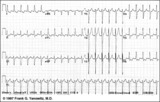 |
Atrial flutter with 2:1 AV conduction | In this example of atrial flutter with 2:1 AV conduction the flutter waves are very hard to see. Atrial flutter with 2:1 block must be considered, however, because the heart rate is about 150 bpm. A careful look at V1 shows the two flutter waves for each QRS complex complex. One flutter wave imme... | Knowledge Weavers ECG | |
| 33 |
 |
Ventricular parasystole | In ventricular parasystole, non-fixed coupled PVC's occur at a common inter-ectopic interval. Fusion beats, indicated by arrows, are often seen. Fusions occur when the sinus impulse entering the ventricles find the ventricles already partially depolarized by the parasystolic focus. | Knowledge Weavers ECG | |
| 34 |
 |
Atrial flutter with 2:1 and 4:1 conduction and rate dependent LBBB | In this example of atrial flutter with variable AV conduction, the faster rates are associated with rate-related LBBB. Don't confuse this for ventricular tachycardia. | Knowledge Weavers ECG | |
| 35 |
 |
Propionyl CoA carboxylase reaction | Propionyl CoA is metabolized by a process that first converts it to D-methylmalonyl CoA. The reaction is catalyzed by propionyl CoA carboxylase,and requires energy in the form of ATP. | Biosynthesis | Knowledge Weavers Fatty Acids |
| 36 |
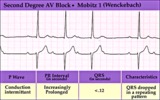 |
2nd degree AV block, type I (Wenckebach) | 2nd degree AV block, type I (Wenckebach) | Knowledge Weavers ECG | |
| 37 |
 |
Diagram: stages of acute Q-wave MI | Diagram: stages of acute Q-wave MI | Knowledge Weavers ECG | |
| 38 |
 |
Accelerated junctional rhythm | Accelerated junctional rhythm | Knowledge Weavers ECG | |
| 39 |
 |
PVC's - marquette | PVC's - marquette | Knowledge Weavers ECG | |
| 40 |
 |
Linoleic acid structure | Linoleic acid is a typical polyunsaturated fatty acid. | Knowledge Weavers Fatty Acids | |
| 41 |
 |
2nd degree AV block with junctional escapes and captures | Second degree AV block is present; conducted beats are identified by those QRS's that terminate shorter cycles than the junctional escape cycle; i.e., the 3rd and probably the 4th QRS's are captures; the other QRS's are junctional escapes. | Knowledge Weavers ECG | |
| 42 |
 |
Atrial fibrillation with moderate ventricular response - Marquette | Atrial fibrillation with moderate ventricular response - Marquette | Knowledge Weavers ECG | |
| 43 |
 |
Ventricular pacing in atrial fibrillation - marquette | Ventricular pacing in atrial fibrillation - marquette | Knowledge Weavers ECG | |
| 44 |
 |
Ventricular pacemaker: demand mode functioning | Ventricular pacemaker: demand mode functioning | Knowledge Weavers ECG | |
| 45 |
 |
Ventricular escape beat - marquette | Ventricular escape beat - marquette | Knowledge Weavers ECG | |
| 46 |
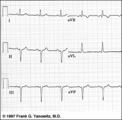 |
LAFB: frontal plane leads | LAFB: frontal plane leads | Knowledge Weavers ECG | |
| 47 |
 |
Old infero-posterior MI | Old infero-posterior MI | Knowledge Weavers ECG | |
| 48 |
 |
Reduction of a 2,4-dienoyl CoA | The reduction of 2,4-dienoyl CoA by NADPH is a step in the oxidation of polyunsaturated fatty acids. It is ironic that a reduction reaction is a required step in a process that is oxidative. | Knowledge Weavers Fatty Acids | |
| 49 |
 |
Stearic, oleic and linoleic acid structures | Stearic, oleic and linoleic acid structures | Knowledge Weavers Fatty Acids | |
| 50 |
 |
2nd degree AV block, type I | The 3 rules of classic AV Wenckebach are: 1. decreasing RR intervals until pause; 2. the pause is less than preceding 2 RR intervals; and 3. the RR interval after the pause is greater than the RR interval just prior to pause. Unfortunately, there are many examples of atypical forms of Wenckebach wh... | Wenckebach AV Block | Knowledge Weavers ECG |
